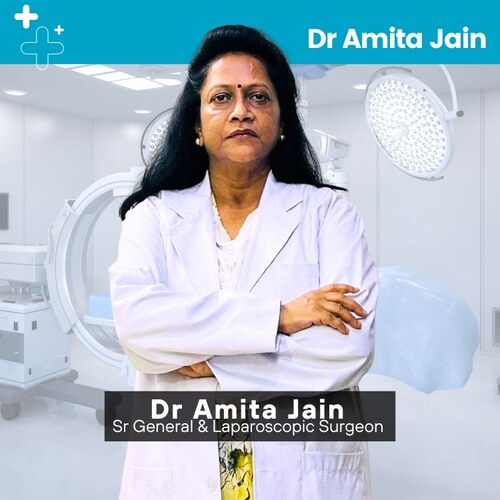Hernias are common conditions where an internal organ pushes through a weakened spot in the surrounding muscle or tissue, causing a noticeable bulge that may appear during activities like lifting heavy objects or standing. Although some hernias may be asymptomatic, many eventually require surgery. Approximately 10% of people will experience a hernia in their lifetime, with over a million abdominal hernia repairs performed annually.
Dr Amita Jain, a top laparoscopic and hernia repair surgeon in Delhi and Gurgaon focuses on paraesophageal hiatal hernias—a specific and concerning type of hernia. To understand this, it’s important to know about hiatal hernias in general. A hiatal hernia occurs when part of the stomach pushes through an opening in the diaphragm, the muscle separating the chest from the abdomen.
There are two main types of hiatal hernias: sliding and paraesophageal. A sliding hiatal hernia, the more common type, involves the stomach and part of the esophagus sliding up into the chest. In contrast, a paraesophageal hiatal hernia, though less common, is more serious. It happens when the stomach or other abdominal organs move up into the chest next to the esophagus.
While sliding hernias are usually not alarming, paraesophageal hernias can lead to symptoms like chest pain, upper abdominal pain, or difficulty swallowing. These may require emergency surgery if complications like incarceration or ischemia occur.

What is a Paraoesophageal Hernia?
A paraesophageal hernia occurs when the lower part of the esophagus, the stomach, or other abdominal organs move up into the chest through an opening in the diaphragm known as the hiatus, which normally separates the chest from the abdomen.
Typically, the gastroesophageal (GE) junction, where the esophagus connects to the stomach, is situated just below the diaphragm in the abdomen. However, in a paraesophageal hernia, this junction, along with part of the stomach or other organs, shifts into the chest cavity.
What are the Causes and Risk Factors?
The exact cause of a paraesophageal hernia isn’t entirely clear, but weak supporting tissues might be to blame. Several factors can damage or put chronic, excessive pressure on the related muscles, leading to this condition. These include:
- Injury and trauma
- Chronic coughing
- Lifting heavy objects
- Repeated vomiting
- Straining during bowel movements
Certain factors increase the risk of developing a paraesophageal hernia:
- Aging, particularly after the age of 50
- Obesity
- Smoking cigarettes
What are the Symptoms?
A paraesophageal hernia may be asymptomatic in many cases and hence can go unnoticed.
However, when symptoms do appear, they may include:
- Sudden severe chest pain
- Chest pain that radiates and isn’t relieved by antacids
- Difficulty swallowing
- Stomach pain
- Indigestion (dyspepsia)
- Nausea
- Vomiting
- Retching (dry heaves)
Since these symptoms can resemble those of other gastrointestinal issues, it’s crucial to get a precise diagnosis from a doctor.
What about the Diagnosis?
A paraesophageal hernia is often diagnosed incidentally through imaging techniques such as chest X-rays, CT scans, or MRIs.
For patients with symptoms, a barium swallow test may be performed, where a contrast agent is ingested and X-rays are taken to visualize the esophagus and stomach.
An upper endoscopy (esophagogastroduodenoscopy), is done under sedation. In this method a thin camera is inserted to directly view the upper gastrointestinal tract.
Also, manometry can be utilized to assess esophageal pressure, revealing whether the esophageal muscles are too loose or tight.
CT scans are also employed for detailed surgical planning.
Treatment Post-Treatment Care
People with symptoms like abdominal pain, gastrointestinal bleeding, or reflux from a paraesophageal hernia are usually advised to undergo surgery to avoid serious complications like strangulation. The surgery typically involves repositioning the stomach and reinforcing the diaphragm with sutures and mesh to prevent recurrence.
Laparoscopic surgery, using five small incisions and a camera for real-time imaging, is often preferred over open surgery due to its advantages: quicker recovery, less pain, and a lower risk of infection. Patients usually stay in the hospital for one to two days, follow a liquid-to-soft-food diet, and avoid strenuous activities for about six weeks.
Post-surgery, some temporary side effects, such as difficulty swallowing or bloating, are common but generally resolve with time. Adhering to postoperative care and attending follow-up visits are important for a smooth recovery.
Understanding the nature of a paraesophageal hiatal hernia highlights its potential risks, especially when symptomatic. Diagnosis often requires imaging and endoscopy, while laparoscopic surgery provides an effective and minimally invasive treatment option.

Dr Amita Jain is one of India’s most distinguished and experienced female surgeons, known for her unmatched expertise in general and laparoscopic surgery. With over 29 years of surgical excellence, Dr Amita Jain has built a reputation for precision, compassionate care, and advanced surgical techniques.
Dr Amita Jain has successfully performed a wide range of complex general surgeries, including both open and minimally invasive procedures, with a strong focus on trauma care, onco-surgical techniques, and reconstructive surgeries. Her areas of specialisation include (including Gallbladder stone removal, appendix removal, hernia repair surgery, piles and fissure surgeries). She was the Professor of Surgery at the Army College of Medical Sciences and Base Hospital, Delhi Cantt. In 1994, she was commissioned asa Surgeon under the United Nations Mission in Congo. From 2020 to 2022, she worked with Bansals Hospital. Currently, Dr Amita Jain is the Senior General and Laparoscopic Surgeon at Rainbow Children Hospitals (Malviya Nagar, Delhi), Artemis Lite: Multi-Speciality Care Hospital (New Friends Colony, New Delhi) and at Rosewalk – Luxury Maternity Hospital in Delhi (Panchsheel Park, Delhi)
Call Us at +(91) 882-6615301